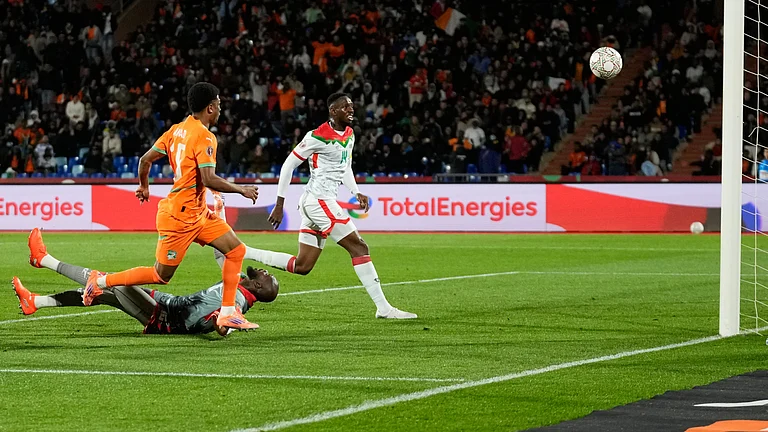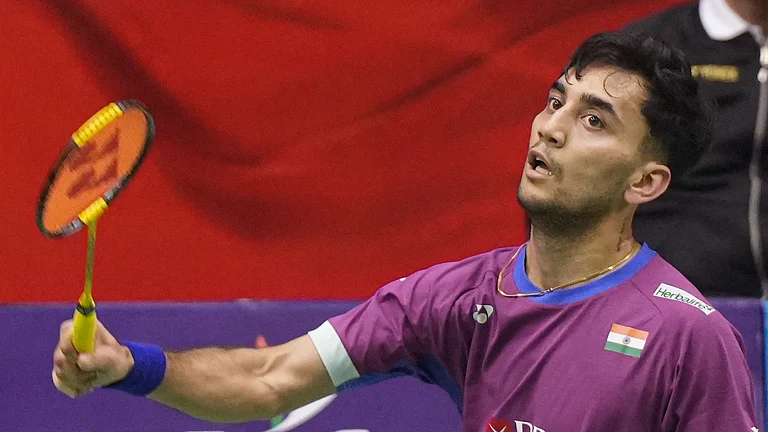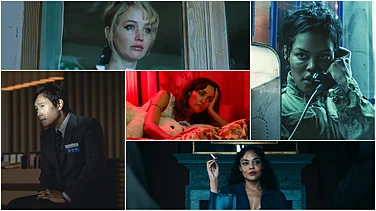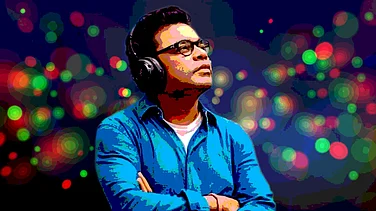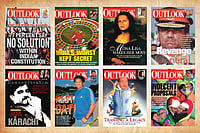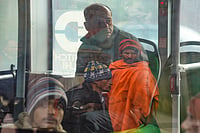For Baroda-based Rekha Rodwittiya, recipe is the "word that evokes the ability to conjure, of realising an intention to its most plausible state of completion". She raises cliche to the level of art in canvases that depict what the French call maison plas : the preparatory rites, the laying out, chopping, peeling, slicing that precede the performance of the cooking ritual. In one work, woman, knife in hand, sits amidst watermelon slices; in another, a plantain leaf platter depicts the all-too-obvious phallic symbol, a banana, some rice that undoubtedly connotes fertility, ovaryesque cashew nuts and blood-red beetroots. The mortar-and-pestle image in a third canvas communicates the 'daily grind' message, the spices-and-condiments display in the fourth reinforces the seed and germination, petty minutiae of a woman's existence theme. The leitmotif is that of spoon and knife. A laden image. Woman may nurture with one, abruptly emasculate with the other.
Madras-based Vasudha Thozur's work recalls Ganesh Pyne's in its brilliant subtext and sheer evocative quality. Not food. Rather the setting of, the instruments for, its consumption fascinate this painter. In one oil-on-canvas, huge candelabra looms in the foreground, fronts piece to the table set with sentinel-like wine glasses in the background. Elsewhere, elaborately laid out place settings await the absent diner, the lord and master represented in the phallictrail that seems to lead to a dark cavern in the painting she calls My House . The reference to woman's subjugated, relegated role is unmistake able. Rites of Passage depicts yet another be frocked table beneath which an animal figure lurks, beyond which lush plants loom. Metaphor for the animal state of the consumer, the vegetable state of the consumed that conjure recipes?
For Manisha Parekh, recipes are about layering. Both of emotion and ingredient. A feeling she expresses in kitchen objects fashioned from layered paper. The ritual nature of kitchen activity, the symbiotic link between this and women's lives, the recipes for survival women devise to survive the drudgery of repeating these rituals for whole lifetimes came as a revelation to painter Bharti Kher who moved to India only in her mid-20s. "The whistle of pressure cookers in neighbourhood apartments defined my time. And the diurnal round of neighbouring women's lives." That wonder about how or whether women found any meaning in their lives, within the spaces of the triad "cooking, eating and defecating", finds expression in her work that depicts chemical test tubes, "...alchemical recipes are similar to cooking recipes, aren't they, in their careful measures?", a tree of life, man defecating into trench latrine at the base of which flowers grow. An audio of pressure cooker whistles—"to me an orgasmic sound, also a metaphor for stress release"—of clinking pots, the rush of tap water, all sounds from women's audios-capes, play in the background.
Sculptress Anita Dube's internally lit, white, tower-like work with glass marble eyes, iron hair cascades, kolam pattern water channels circling it in which red water flows is her comment on the kitchen where women dwell and are often interned. "Kitchens can be empowering collective spaces of sharing, caring, governing for women. They can also be claustrophobic, confining," she says. Those glass eyes are a survivor's eyes, red water the lifeblood of victims of the kitchen, those confined to recipes of subjugation evolved by men. She offers baked mud eyes on skewers to visitors to the exhibition as memento and metaphor for the confined woman's state.
Much else is on offer. A screening of Like Water for Chocolate : the Mexican classic that both celebrates and condemns kitchendom, a talk on food, its form, its substance, basic distinction between tastes of necessity and tastes of luxury by chef Claire Dutta. Much food for thought at this exhibition for gourmets of the mind.









